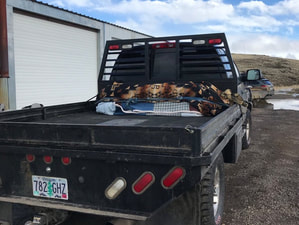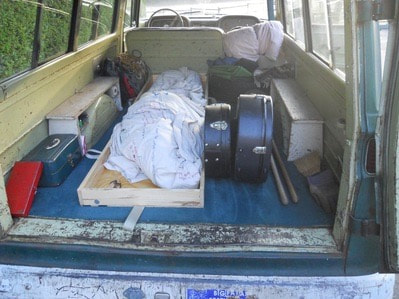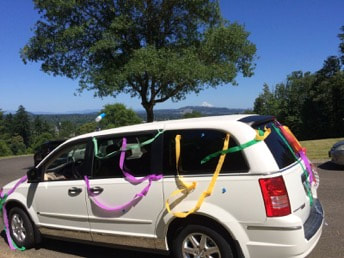The Final Ride |
On This Page |
|
In the Pacific Northwest, it’s rare to see a conventional formal funeral procession led by a police escort and a hearse carrying the casket, followed by a long line of cars driving slowly with headlights on. Families may choose to create their own procession to the place of ceremony or final disposition; to forgo the ceremonial aspects and provide their transportation in a suitable vehicle of their own; or to hire a funeral home or direct-to-cremation provider to handle transportation.
|
|
Legal Issues
In Oregon, it is legal for a family member or friend to transport a deceased body. This could include transportation from place of death to place where viewing or ceremony will take place (for example, at home if death didn’t occur at home, or to a place of worship or community or ceremony hall). You can also transport to final disposition for a burial or cremation. The death certificate, once signed by the medical certifier, serves as the transportation permit (required only for transfer to place of final disposition). For details about obtaining and completing the necessary paperwork and metal tag, go to How to Complete Paperwork.
Even though a transportation permit (i.e., the death certificate, once signed by the medical certifier) is required only for transferring the body to burial or cremation, there are hospitals and care facilities that are unfamiliar with Oregon families’ rights under the law. Because businesses can write their own policies, such institutions may have body release protocols in place that insist or imply that use of a funeral services company is required, or that transferring the body back home or to another location prior to disposition requires completion of the 24 Hour Death Notice and Death Certificate. To address this barrier, see How Oregon Hospital Staff and Administrators Can Support Oregon Families in Caring for Their Own Dead and Sample Hospital Policy Language Regarding Removal of the Body.
Funeral homes must embalm, refrigerate, or place in a sealed casket if body is not expected to reach destination within 24 hours, by regulation, not statute--this rule applies to funeral directors only. A sealed casket may substitute for embalming when shipping by common carrier.
Even though a transportation permit (i.e., the death certificate, once signed by the medical certifier) is required only for transferring the body to burial or cremation, there are hospitals and care facilities that are unfamiliar with Oregon families’ rights under the law. Because businesses can write their own policies, such institutions may have body release protocols in place that insist or imply that use of a funeral services company is required, or that transferring the body back home or to another location prior to disposition requires completion of the 24 Hour Death Notice and Death Certificate. To address this barrier, see How Oregon Hospital Staff and Administrators Can Support Oregon Families in Caring for Their Own Dead and Sample Hospital Policy Language Regarding Removal of the Body.
Funeral homes must embalm, refrigerate, or place in a sealed casket if body is not expected to reach destination within 24 hours, by regulation, not statute--this rule applies to funeral directors only. A sealed casket may substitute for embalming when shipping by common carrier.
Practical Considerations
There are practical and logistical considerations that are important for families to evaluate prior to deciding to transport a body themselves. Here are a few:
- Take into account the size and weight of the deceased. There are physical risks involved for those who are doing the lifting and moving, so be realistic about who will be on hand at critical moments that require strength and flexibility. It's good to have 4 - 5 people strong enough to do sustained lifting and moving.
- Measure doorways that lie in the path you plan to take when moving the body, with particular attention to stairs. If you plan to place the body in a casket before moving, be sure the container will be able to make corners easily without squishing carriers. It's a good idea to practice with an empty container before trying it with a heavy body inside to plan strategies.
- Bodies go in and out of rigor, so they require a rigid base for ease of moving. You might use an alternate container tray, a shroud with a built-in board, a shrouding or lowering board, a backboard, a cardboard casket, a wooden casket—anything that supports the body, is easy enough to grip and carry, and that feels stable enough to make the distance both on the way out and at the destination.
- It is sensible and courteous to have a closed vehicle or cover of some kind to avoid problems with weather and to be sensitive to people along the route.
Max's Last Ride in the Flatbed TruckOnce the county medical examiner finished investigating four-year-old Max’s accidental death, authorities mistakenly required the involvement of a funeral home to release his body. After several days to clear the red tape, his parents transported Max to his home on the back of a flatbed pick up and buried him at the foot of his grandmother in their ranch cemetery.
Read more... |
Sheet for a Shroud, '62 Chevy for a HearseFour days after Mark's death, Phyllis and friends loaded him into “Pete,” a 1962 Chevy Suburban that had taken them on many a camping excursion over the prior 28 years. It was, Phyllis says, “a perfect hearse for Mark's last ride.” Carloads of friends and family joined the procession down the Gorge and through Eastern Oregon.
Read more... |
Kids Make Funeral Home Van FestiveMarcy tasked her sister with sewing her shroud, her brother with building a lowering board, and her closest friends with preparing her body for her green burial. With steep steps from their home and the exhaustion of her long illness, her husband decided to leave the transportation to a funeral home. The children used streamers to make the generic transport van more festive.
Read more... |



